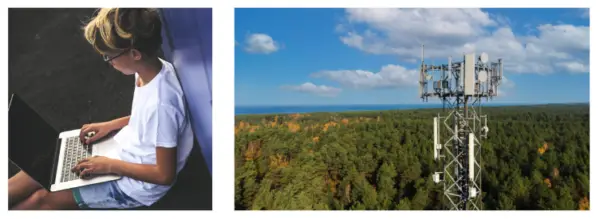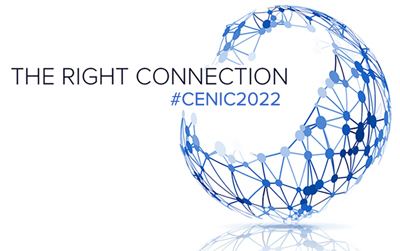- About
- Network
- Community
- Initiatives
- News
- Events
- Blog
- Publications

Old Problems Need New Solutions: Digital Equity in California
Categories Equity & Access
To solve problems that have never been solved, we must do things that have never been done.
In a nutshell, this was the message shared by California leaders in economic development, higher education, policy, and infrastructure during the “Digital Equity in California” panel at CENIC’s 2022 Conference that took place this September in Monterey, CA.
During the discussion moderated by Erik Hunsinger, GoldenStateNet's Vice President for Infrastructure, panelists described creative new approaches to funding, infrastructure, partnering, and community engagement used by their organizations to expand broadband access to historically un- and underserved rural and urban communities in California.
Golden State Connect’s Innovative Municipal Model
Barbara Hayes, Chief Economic Development Officer for the 39-county-member Rural County Representatives of California (RCRC), kicked off the morning by recalling the early pandemic image of two little girls sitting on the curb of a Salinas, CA fast-food restaurant so they could use the free wifi to complete their homework. The image quickly went viral, illustrating what Hayes called “the chasm between the haves and have-nots relative to broadband.”
Hayes then pointed to the critical importance of SB 156, an historic piece of California legislation providing the framework for an open-access middle-mile network to connect local communities to the global internet at future-facing broadband speeds. This piece of legislation led RCRC to create Golden State Connect with the goal of ensuring quality internet for rural Californians. As a Joint Powers Authority, Golden State Connect will issue bonds to finance a new open-access municipal model for broadband deployment where service providers can all use the same publicly-owned network to provide services to homes and businesses.

Economic Development for California’s Remote North Coast
Connie Stewart’s two decades of experience with rural connectivity extends from phone lines to fiber-optic cables for the remote and rugged North Coast county of Humboldt. A former Arcata mayor and legislative aide, and current Executive Director of Initiatives for Cal Poly Humboldt, Stewart has modeled unique creativity in connecting the North Coast of California to the world at broadband speeds.
Working with Sunne McPeak of the California Emerging Technology Fund (CETF), Stewart helped conduct a study showing how they could aggregate sufficient resources to support the maintenance of broadband if there were a way to fund its installation. This spurred creative economic development ideas as the community recognized that it was a perfect location for a subsea cable landing station, being closer to Asia than anyplace else in the continental US. This advantage, together with inexpensive alternative power to support large data centers, brought Google, Facebook, and Trans Pacific Networks to the table with support.
The rural community is also one of the most seismically active areas in the continental US and is working with the US Geological Survey to develop early warning systems for earthquakes and their impact along the coast.
Innovative Ways to Engage and Build Trust
Both Bill Allen, President and CEO of LA County Economic Development Corporation (LAEDC), and Debbie Shireman, CETF’s Director of Digital Inclusion, focused on the challenges of building trust with underserved communities both urban and rural.
“Lack of connection goes beyond rural communities to urban households with little to no service due to affordability issues,” said Allen. “At a time when access to affordable broadband needs to be considered a civil right, just like water and power, we found our biggest issue to overcome is a lack of trust, particularly toward commercial providers.”
"The CETF has established a program called Get Connected with a call center to help people fill out applications to access reduced-cost internet,” said Shireman. “Since December we’ve fielded 20,000 calls needing our help.” In addition, Shireman noted that those obtaining new broadband access need an introduction to make the most of their new connection, so her team is working with libraries and other organizations already known and trusted in these communities to provide training to newly connected users.

No Fiber? No Problem: Creative Infrastructure Solutions
GeoLinks’ Melissa Slawson rounded out the panel, representing one of the latest disruptive technologies to come from a California garage. “GeoLinks was started because the founders lived in Ojai, an agricultural and rural area, and they wanted to develop a solution to better internet service,” said Slawson. “Their flagship solution is ClearFiber, fixed wireless that fills gaps and can act as a pseudo-fiber replacement. It’s much faster to deploy than fiber and reaches areas that fiber can’t or won’t.”
“We’ve been able to leverage FCC grant funding to support some of these initiatives, and are developing self-install equipment for customer premises to overcome trust issues for those who don’t want a company coming into their home,” said Slawson.
Eric Hunsinger wrapped the session with a sobering note on the plight of those without broadband access. “They are left behind,” he said simply. “They’re forgotten and do not have a voice, and this panel is bringing their voices to life for us.”

More Right Connection content for you.
You may access session slides and videos at the links below.
• Presentation slides
• Video playlist of all streamed sessions
Related blog posts
CENIC Members Bolster the Economy by Expanding Digital Literacy in California
Members of CENIC are working to improve digital literacy by supporting initiatives aimed at creating digital access for more Californians and by creating programs to enhance digital literacy once those people have been connected.
Ventura County Library Capitalizes on CENIC Membership to Provide eduroam Connectivity to Student and Faculty Patrons
By becoming eduroam Hotspot Operators, Ventura County Library and its branches offer the extremely valuable service of eduroam connectivity to its student and faculty residents.


